
When it comes to cultivating a garden that flourishes with vibrant blooms and bountiful harvests, the real challenge often lies in keeping unwanted pests at bay. Recently, I had the pleasure of speaking with Emily Cartwright, an experienced horticulturist and avid gardener, who has mastered the art of creating a pest-proof sanctuary in her own backyard. Her insights into companion planting, soil health, and natural pest control were both enlightening and practical, offering valuable lessons for gardeners of all experience levels.
Turn your garden into your private retreat, enjoyable day or night complements of Elegancia.homes.
Emily’s garden, nestled in the heart of the Cotswolds, is a testament to the harmonious balance between nature and nurture. Her approach, she explained, is rooted in the concept of companion planting – a technique that involves growing certain plants together to enhance their growth and deter pests. As we strolled through her flourishing plot, Emily shared her experiences and tips on how to create a garden that not only thrives but also naturally resists pest invasions.
Companion Planting: Nature’s Own Defence
“One of the simplest yet most effective strategies I’ve employed is companion planting,” Emily began, pointing to a bed where vibrant basil plants stood proudly alongside towering tomato vines. “For example, basil has been a game-changer for my tomatoes. Its strong aroma repels common pests like aphids and whiteflies, allowing the tomatoes to grow without interference.”
Emily emphasised the importance of researching and experimenting with various plant combinations. “Every garden is different, and what works for one might not work for another. However, some pairings are classic for a reason. Marigolds are another favourite of mine; they deter nematodes and other insects, making them ideal companions for a wide range of vegetables.”
The concept of companion planting extends beyond mere pest control. Emily explained how certain plants can enhance each other’s growth, citing the example of planting beans alongside corn to provide natural support and enrich the soil with nitrogen.
The Foundation of Healthy Soil
As we continued our tour, Emily paused by a patch of soil rich in texture and colour. “Healthy soil is the backbone of any pest-proof garden,” she asserted. “Strong, healthy plants are naturally more resistant to pest attacks.”
Emily’s secret to maintaining fertile soil is regular composting. “I make it a point to enrich my soil with organic matter like compost. It improves the soil structure and provides the nutrients plants need to grow strong and resilient.”
She also highlighted the importance of avoiding overwatering, which can create conditions conducive to pest infestations. “Watering at the right time and in the right way is crucial. I always water at the base of the plants in the morning, which helps prevent moisture-loving pests from settling in.”
Natural Pest Control: Embracing Beneficial Insects
Emily is a firm believer in working with nature rather than against it. “Introducing beneficial insects into your garden is a fantastic way to control pest populations naturally,” she explained, pointing to a cluster of ladybirds nestled among the leaves.
“Ladybirds, lacewings, and parasitic wasps are all allies in the fight against garden pests. They prey on aphids, caterpillars, and other harmful insects, reducing the need for chemical interventions.”
In addition to welcoming beneficial insects, Emily employs natural remedies such as neem oil and garlic spray. “These are effective at deterring pests while being gentle on the plants and the environment. It’s all about finding that balance.”
Physical Barriers and Crop Rotation
Emily’s approach to garden management also includes practical measures like physical barriers and crop rotation. “Using row covers or netting can physically prevent pests from reaching your crops,” she advised. “And rotating your crops each season helps disrupt the lifecycle of pests that target specific plants.”
She explained how these methods not only prevent infestations but also contribute to the overall health of the garden. “It’s about creating an ecosystem where pests find it difficult to settle and thrive.”
A Continuous Learning Journey
As our conversation drew to a close, Emily left me with a reminder that gardening is an evolving practice. “Creating a pest-proof garden is a journey of learning and adaptation,” she reflected. “Stay informed about the pests common to your region and keep experimenting with different techniques.”
Emily’s passion for gardening and her commitment to sustainable practices were truly inspiring. Her garden is not just a haven for plants but a living example of how thoughtful planning and a keen understanding of nature can keep pests at bay. For anyone looking to nurture their own patch of paradise, Emily’s insights offer a valuable roadmap to success.
By incorporating these strategies into your gardening routine, you can cultivate a vibrant and resilient garden, much like Emily’s, where plants thrive and pests are kept at a respectful distance.
Sarah Dale


Be the first to comment